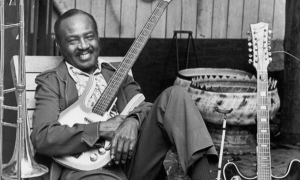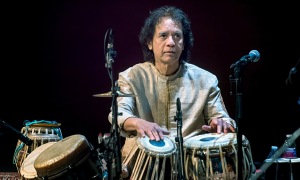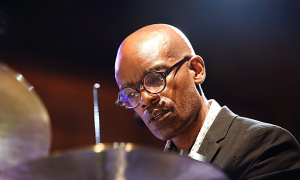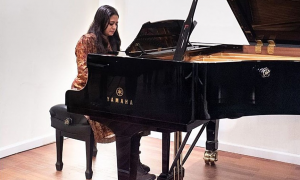Home » Jazz Articles » Under the Radar » Blue Highways and Sweet Music: The Territory Bands, Part I
Blue Highways and Sweet Music: The Territory Bands, Part I

A huge marine stepped onto the bandstand, came over to me and told me that if we played the anthem once more, I may not live to see the sun come up.
—Elroy Vernon Lee
Origins
By the second half of the 1920s, New York had supplanted Chicago as the center of jazz. The "Jazz Age"—a label incorrectly ascribed to F. Scott Fitzgerald—could rationally have been framed as the "Dance Age." Prohibition, and the speakeasies that it spawned, were packed with wildly enthusiastic patrons of the Charleston, Black Bottom, Shimmy, Collegiate Shag, the Baltimore and the Lindy Hop. It was often a simple step or two that distinguished one dance from another, but the physical demands of those dances made them the domain of the young -the ideal target market for the venues and the merchandise that they offered. Many historians of the Jazz Age attribute the popularity of the era's new dance music—and the bands that played it—to one incomparable couple: Vernon and Irene Castle.A native of Norfolk, England, Vernon Castle and his New York-born wife, Irene, came to prominence in a 1914 Broadway production of Irving Berlin's Watch Your Step where they had polished and promoted the recently developed Foxtrot. That popular dance had been attributed to a white vaudevillian actor and dancer—Harry Fox—but multiple sources credited Castle with having witnessed the dance being performed by African Americans fifteen years prior to Fox's "invention." The Castles also helped to popularize ragtime, jazz rhythms, and African-American music for dance, and the pair was highly in demand as dance instructors and performers. After establishing themselves in New York, they became stars in Paris, and returned to New York more famous than when they left. The Castles became major dance entertainers on Broadway, appeared in movies and toured with the famed black orchestra, of James Reese Europe. Vernon Castle was a decorated pilot in the Royal Air Force in World War I and died—at the age of thirty—while training other fighter pilots. Already renowned globally, the emotional impact of Castle's death cemented the couple's place in modern dance history, and dance bands across the U.S. and Europe were influenced by their artistry. The British tabloid The Daily Express cited the Castles as the "world's most influential dance team" (Oct 6, 2014).
The relative affluence of the 1920s (after a brief post-war recession) was driven in large part by an end to the economic repression of World War I. The public and manufacturing sectors conserved their spending and now had amassed stockpiles of money. Technologies, in the form of radio, cinema and more affordable automobiles, allowed the mass public to hear, see and be part of the proliferation of new music in a way that had been previously limited. But the benefits of this phenomena were not equally distributed among Americans, and the economic boon felt in the cities was not realized over the rest of the country. For the first time, more people were living in major cities where production facilities and corporate offices were based, and jobs were plentiful. In rural areas, a decades-long collapse of agricultural prices began in the same time period, and farming jobs—which had accounted for nearly half of all pre-war U.S. jobs—were now half that number. Still, those living in rural areas had access to local movie houses and radio and they were an enthusiastic audience for dance bands. Many areas of the South didn't have electricity until the mid-1930s, but even in these remote locations, crystal radio receivers were common; not requiring electricity, and frequently built from home kits, they were relatively inexpensive. Radio crossed geographic, racial and economic barriers, bringing the likes of the Original Dixieland Jazz Band, Louis Armstrong, Benny Goodman, New Orleans Rhythm Kings, Paul Whiteman and Duke Ellington to the majority of U.S. households. Far beyond the epicenters of 1920s jazz—Chicago, New York and Los Angeles—largely unknown musicians in Oklahoma, Nebraska, Texas, Missouri and other locations had ambitions of capitalizing on the mass popularity of the movement. Those aspirations were the anthropological reason for the creation of the territories bands. The performers were not only responsible for bringing live, early jazz music to much of the country, but they also produced a substantial number of artists who would go on to become major attractions.
Two Realities
A comprehensive history of territory bands does not exist though there were hundreds of these professional and semi-professional bands from the 1920s to the 1960s, but far fewer post-Great Depression. They were a critical part of the dissemination of jazz inside the United States but their nomadic nature and instability made the vast majority of territory bands unsustainable and difficult to document. For each musician that came out of the ranks of these bands and went on to fame, hundreds of others were lost to the past. The bands propagated a variety of popular music styles of the era including swing, jazz, and sweet music. "Sweet music" was a somewhat disparaging branding of styles that were often in direct opposition to jazz: waltzes, polkas, and light mood music of European origins. The bands brought their music to hotels, run-down bars and clubs, dance halls and local lodges disregarded by national booking agents. The defining characteristics of physical "territories" left enough slack for some crossover. Larger groupings were based on traditional geographic regions such as Northeast, Southeast, etc. Groupings of states emerged, marked by the acronyms "MINK" (Minnesota, Iowa, Nebraska and Kansas) and "VSA" (Virginia, South Carolina, and Alabama) while Texas had so many bands that it constituted its own group. Dallas-Fort Worth, Houston, San Antonio, Austin, and Amarillo were just a few of the Texas cities that served as hubs for territory bands. Those bands had large in-state followings and they rarely found it necessary to cross state lines for work. The largest concentrations of territory bands were in the Great Plains, with urban hubs in Kansas City, St. Louis, Omaha, Oklahoma City, Dallas and Houston. In smaller numbers these bands existed in many other parts of the U.S. from New York to Los Angeles; smaller centers were located as far north as Fargo, North Dakota, Minneapolis, and Milwaukee and east to Atlanta and Charlotte, South Carolina. Booking agencies assembled traveling bands from the regional pools and arranged successions of one-night performances in more remote locations within their area.There are few first-hand accounts of life on the road but if Elroy Vernon Lee is to be believed, this description would represent a typical night in the life of a territory band: under the pseudonym, Lee Barron, he was playing a one-night stand at a barroom in St. Joseph, Missouri in 1944. While his thirteen-piece namesake orchestra was performing, a brawl broke out and quickly escalated, with broken beer bottles and their owners scattering across the dance floor. Quickly thinking, Barron sent a covert signal to the band and they seamlessly transitioned to their version of the National Anthem, bringing the scuffle to an immediate halt as the room sprang to standing attention, hands over hearts. The Lee Baron Orchestra resumed their planned program only to have fighting break out three more times; each incident was stopped by switching to the anthem until the bodies were dragged from the dance floor. On the band's next Pavlovian attempt at peace, Barron remembered: "A huge marine stepped onto the bandstand, came over to me and told me that if we played the anthem once more, I may not live to see the sun come up."
Barron's Odyssey of the Mid-Nite Flyer is the only known full-length book dedicated to the subject of territory bands. A 1987, self-published, uncorroborated combination of picture book and memoir, it is told from a single point of view. Though the book is described by the author as "a history," it offers little in the way of perspective on territory bands, other than by omission. The critical lapse is in Barron's near-complete disregard of the role of black musicians in his account of territory band folklore. The book contains roughly two-hundred publicity photographs of bands and leaders, only one being of a black group -equal to the number of photos showing a white musician in black-face. In his text, he offers a single sentence to the influential bandleader Nat Towles, and that is a subtext to praising Towles' booking agent. There is little comparison in subject integrity between Mid-Nite Flyer and the thirty pages that Gunther Schuller dedicates to territory bands in his seminal work, The Swing Era: The Development of Jazz, 1930-1945 (Oxford University Press, 1989). In the second-part of his history of jazz, Schuller is very specific in his observation: territory bands were black bands. The underlying forces that support Schuller's case are in the different dynamics of the black and white barnstorming groups. Generally speaking, white bands were given preferential treatment in choice of venues, length of engagements, recording opportunities and travel accommodations. Barron is hardly alone in his questionable ignorance of the black territory bands. Jack Behrens' self-published American Music Makers: Big Band & Ballrooms 1912-2011 (2011) is cheerfully oblivious to the contributions of musicians of color. It was outside the U.S. that a jazz historian painted a more color-blind picture of the era, with English discographer Albert McCarthy's Big Band Jazz (Exeter, 1983) providing much needed coverage of the black bands of that time period.
Texas
Texas provided its self-contained territory bands with more well-established—and permanent—ballroom venues than any of the other Great Plains states. While speakeasies, nightclubs and lodges accounted for many venues, groups were regularly booked into the ballrooms of hotels such as the Galvez Hotel in Galveston, Rice in Houston, Mineral Wells' Baker Hotel, the Plaza Hotel—one of many venues in San Antonio—the Waco Hotel and the Adolphus in Dallas. Dallas had a number of talented bands but the city presented black groups with a harrowing societal enigma. In his book Blue Highways—A Journey Into America (Fawcett Crest, 1982) William Least Heat-Moon talks about the dilemma of blacks traveling in the Deep South, saying that it was "easier for a black man to get a lift on the small roads where there were more Negro drivers." What was a convenience in Least Heat-Moon's 1978 travelogue was more a matter of survival in the 1920s Texas. Henderson, Texas is located about two hours southeast of Dallas though the ride would have been considerably longer and more convoluted in the 20s. For black territory bands of the era, Henderson was among the destinations that provided safer venues; safety being a major concern as Dallas was then considered to be the most racist city in America. As reported by the Dallas Morning News on April 5, 1922, one out of every three males in Dallas was a member of the Ku Klux Klan, including white-collar professionals, government officials and members of law enforcement.Texas State Road 40 was long gone when Least Heat-Moon travelled that area. It existed only from 1919 until 1939 running from the Oklahoma-Texas border, southeast to Port Arthur, on the Gulf of Mexico, and passing just west of Henderson. Part of the two-lane, undivided road ran through Cherokee County and the small cities of Nacogdoches and Peppervine, the ghost towns of Ghent, Manila and Java and vast expanses of wild grasses, thistle, and bamboo. Small, unincorporated pockets of civilization with a gas station, grocery store and planked walkways, popped up in the middle of nowhere. The physical landmarks beside that long-gone highway have changed little since the 1920s.
One of the oldest small cities in Texas, Henderson thrived during the Great Depression thanks to the discovery of oil six miles beyond the town limits. Quadrupling its population in a matter of months, it was the quintessential boom town but it hardly had an idyllic history. It burned to the ground in 1843 leading to the questionable accusation of a northern abolitionist who was hung—and shot—by a mob. In the 1960s there was another reputed attempt to torch the town by outsider "hippies." Henderson's largest employer is a prison and one of its three jailhouses dates back to the Jazz Age. Nevertheless, the growth of the town brought amenities and entertainment venues that made it a choice destination for territory bands. In her 2007 thesis Where East Texas Dances: The Cooper Club of Henderson, Rusk County, and Popular Dance Bands, 1932-1942, the researcher Michelle Linsey Holland chronicled a history of the rural nightclub, popular with territory bands. At the time of the oil strike (1931) Henderson's chief source of revenue was cotton, but drought conditions and the collapsed economy had taken its toll on agriculture. Holland points out that the living and working conditions of blacks in Henderson had barely changed since slavery ended and, in some cases, became worse. Some blacks found employment in oil-related jobs but the majority remained as tenant farmers facing rising living expenses and land cheats. Race issues aside, Henderson was ripe for a more robust entertainment scene, and a local entrepreneur, Hugh Cooper, was accommodating to all the town's residents.
Cooper was not a man of means but certainly one of conflicting influences; religious, a non-drinker, and pragmatic he nonetheless married a women twenty years younger than himself, and his idea for a dancehall was more of a whim without an obvious business plan. After having to borrow almost all the necessary funding, Cooper's impulse became a barn-like structure with a capacity of almost three-thousand people. The Cooper Club formally opened in 1935 and proved Cooper to be quite shrewd. The dancehall was immediately successful based largely on Cooper having signed a booking arrangement with the Music Corporation of America (MCA) allowing him to be the first access to top talent in—or passing through—East Texas. Two years later the club burned to the ground but Cooper took his significant profits and rebuilt down the road. Five years later, Cooper opened a second dancehall, the Palm Isle, thirty miles north in Longview, Texas. He later sold the Palm Isle to Mattie Castleberry who owned dancehalls in several Texas and Oklahoma locations. Castleberry brought in "Taxi Dancers"—women who danced with the male patrons for a fee (as in "ten cents a dance,") and then split the fee with management. The two clubs booked Glenn Miller, Tommy Dorsey, Ella Fitzgerald, Jack Teagarden, Louis Armstrong, Paul Whiteman and many other well-known acts.
The Cooper Club would become the principal venue for music in East Texas; a nightspot that had a sophisticated air and the kind of quality talent that rarely made its way to locations such as Henderson. Cooper booked Herman Waldman's Orchestra, a popular Texas band whose members included trumpeter Harry James for a time. The Ligon Smith Orchestra, frequently booked at the high-end Adolphus, also made the trip to Cooper's club. He attracted Jan Garber's band as well. Garber was known as the "Idol of the Airwaves," because of his extensive career in radio performance and more than a dozen sides recorded. These were all white dance bands and they played for white-only audiences at the Cooper Club on all but one night each week. On those nights Cooper, who was white, not only opened the club to black bands and patrons, but roped off a "white section" where those customers could watch and listen, but not dance. Cooper could not advertise the black performance nights. Local newspapers were reluctant to offend white readers and the county sheriff had a reputation for breaking up shows that featured—or catered to—black audiences. Instead, Cooper himself would go into black neighborhoods and hand out fliers for the shows. He would also make tickets available at other outlets such as coffee shops and hotels; he was a strategic marketer ahead of his time. Beyond entertainment, Cooper was popular in the black community. He sold and financed homes to blacks, provided them with business loans and by all accounts collected in Holland's research, did not take advantage of blacks as so many other business people did. The crowning glory for the Cooper Club was booking Duke Ellington in 1935.
In the prime years of the territory bands, popular music was in a wild state of flux. Ragtime's popularity had faded and New Orleans style music gave way to the flavorless dance music of the early-to-mid 1920s. The prevalent styles of the era included show tunes, sweet music, and oddities such as the kitchen sink approach of Skiffle, where black musicians mixed homemade "instruments" like jugs and washboards, with conventional acoustic instruments. Stride piano had become popular in the early 1920s and a wave of jazz recordings came from stride pianist James P. Johnson (The Harlem Strut), Fats Waller and Count Basie. The dancehalls of the southern plains gave birth to Western Swing in the 1920s. The genre merged country music with polka, folk, Dixieland, jazz and blues; its rhythm and instrumentation bearing similarities to Django Reinhardt's Gypsy Jazz. The popularity of the Blues was spreading with singer Mamie Smith recording twenty songs in a band that featured Coleman Hawkins. Race Records came into existence in the 1920s with labels such as Okeh marketing black artists in jazz, blues, and gospel music, to black markets. Major record labels began their own race-based subsidiaries and black music spread to the white demographic. All of these activities helped whet the public's appetite for live music.
Part II of Blue Highways and Sweet Music: The Territory Bands moves north into the territories of the Great Plains as well as the undesignated "territory" of the Mississippi, Missouri and Ohio Rivers. The careers of some standout performers such as Alphonso Trent and Fate Marable will be examined.
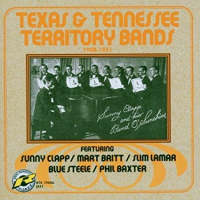 Texas & Tennessee Territory Bands: 1928-1931 (Retrieval, 2006)
Texas & Tennessee Territory Bands: 1928-1931 (Retrieval, 2006) With the exception of the Race Labels, recording contracts generally went to white bands. Some of those bands are represented on Texas & Tennessee Territory Bands: 1928-1931 while others are difficult to identify at that level. Four of tracks are from Sunny Clapp whose own history is thin despite having written more than a half-dozen popular songs that had been recorded by Dizzy Gillespie, Etta James, and Charles Mingus.
Slim Lamar's Southerners account for seven pieces on Texas & Tennessee Territory Bands. Another artist whose history is all but lost, Lamar's Southerners played Biloxi, Mississippi, Memphis, Tennessee, Louisville, Kentucky and as far north as the Egyptian Room of the Kosair Hotel in Indianapolis.
 That Devilin' Tune: A Jazz History (1895-1950), Vol. 1 (1895-1927) (West Hill Radio Archives, 2011)
That Devilin' Tune: A Jazz History (1895-1950), Vol. 1 (1895-1927) (West Hill Radio Archives, 2011) That Devilin' Tune: A Jazz History (1895-1950), Vol. 1 (1895-1927) is an ambitious and wide-ranging collection of nine CDs. Taken from their original 78rpm format, it is an assortment of names that may be familiar listeners with a sense of history, as well as those who are unknown. Information on the tracks is scant and there are some tracks that are not as listed.
Mamie Smith, Bennie Moten, Charlie Creath and Fate Marable are among the artists whose history includes time with territory bands. The overall collection pre-dates the territory band era and includes The Original Dixieland Jass Band, Jelly Roll Morton and Bix Beiderbecke.
Photo Credit: countbasieinconcert.com
Tags
Under the Radar
Karl Ackermann
James Reese Europe
Original Dixieland Jazz Band
Louis Armstrong
Benny Goodman
The New Orleans Rhythm Kings
Paul Whiteman
duke ellington
Glenn Miller
Tommy Dorsey
Ella Fitzgerald
Jack Teagarden
Harry James
Fats Waller
Count Basie
Coleman Hawkins
Etta James
Charles Mingus
Jelly Roll Morton
Bix Beiderbecke
PREVIOUS / NEXT
Support All About Jazz
 All About Jazz has been a pillar of jazz since 1995, championing it as an art form and, more importantly, supporting the musicians who make it. Our enduring commitment has made "AAJ" one of the most culturally important websites of its kind, read by hundreds of thousands of fans, musicians and industry figures every month.
All About Jazz has been a pillar of jazz since 1995, championing it as an art form and, more importantly, supporting the musicians who make it. Our enduring commitment has made "AAJ" one of the most culturally important websites of its kind, read by hundreds of thousands of fans, musicians and industry figures every month.








